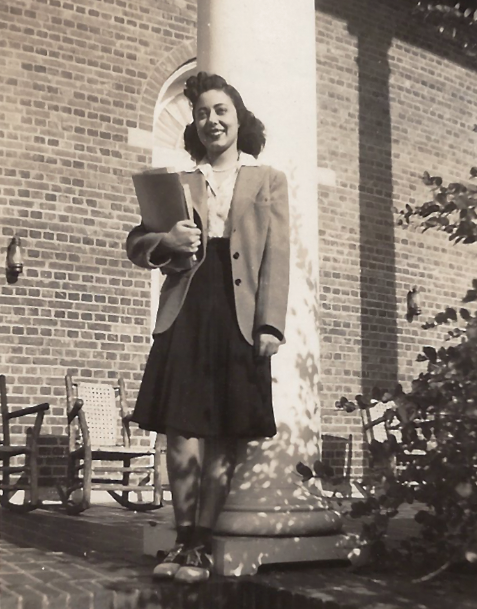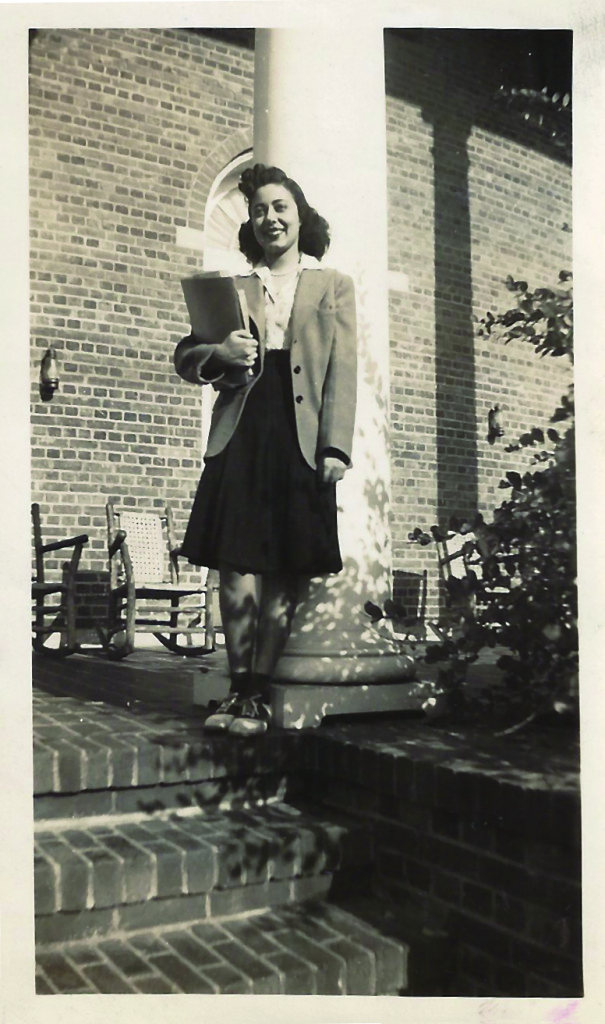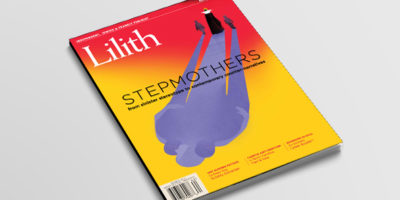
A Jewish Co-ed in North Carolina, 1941
The state making news for gender bias in 2016 is staying in character. Seventy-five years ago, anti-Semitism was a preferred prejudice in North Carolina.

Esther Braun in front of McIver Hall.
One September day in 1941, Esther Braun, a tiny 19-year-old with a shock of curly black hair, daughter of Jewish immigrants, got off a train in Chapel Hill. This was her first time away from home — a shabby New York neighborhood of small brick two-family houses and bungalows on Queens’ Rockaway Peninsula. After two years studying chemistry at Brooklyn College, she was going to complete her degree at the University of North Carolina.
Esther arrived at McIver Hall, one of three women’s residences surrounding a quad carpeted with soft grass. The weather was hot and glorious. She dropped her luggage in her empty room — her roommate hadn’t yet arrived — and set out to explore. She walked across the street to the arboretum, with its carefully labeled flowers and plantings, and followed a path into the main campus of grand Beaux-Arts-inspired brick buildings and a huge expanse of lawn where students sprawled under ancient shade trees. At the main campus entrance, Esther noticed a statue of a Confederate soldier on a high pedestal, guarding over the university like a genius loci. A plaque affixed to its side read: To the sons of the university who entered the war of 1861–65 in answer to the call of their country and whose lives taught the lesson of their great commander that duty is the sublimest word in the English language.
Esther, my mother, had never before been in such beautiful surroundings. Her life as a teenager had been grim, with a two-hour commute each way to Brooklyn College. Though her father had lost everything during the Depression, he had somehow scraped together enough money to send his daughter to college, out of state; he had wanted this badly for her. Now she was going to be studying in the middle of this paradise.
Time to unpack. She returned to McIver, climbed the stairs to the third floor, opened the door off the stairwell, and found the suitcases she’d left inside her room piled up in the hallway.
Was there some mistake? Esther hurried to the office of the housemother. At this point, the precise details of my mother’s story — who exactly said what to whom — are lost. But the important part is clear. Her assigned roommate, like most students at Chapel Hill a resident of the State of North Carolina, had taken one look at those baggage tags — “Esther Braun, Edgemere, New York” — and moved the offending luggage out of the room immediately. Then, Miss North Carolina marched to the housemother to announce: “I refuse to room with a Jewish girl.” The housemother conveyed this hateful message to my mother without apology.
I wish I had been there: Was the housemother embarrassed? Exasperated? Maybe this was not the first time she had to deal with this “problem.”
Certainly this was my mother’s first encounter with overt anti-Semitism. Although she’d experienced it indirectly, coming of age as Henry Ford and Charles Lindbergh were warning the country that the Jews were poisoning America, and Father Coughlin was ranting against Jews on his weekly radio program. Jews in America felt vulnerable, and even more so in 1941, as the news from Europe became more alarming with each day. This was the world Esther knew when she stood before the housemother, listening to why her luggage was dumped into the hallway, a contaminant of the room where she had left it.
I imagine that Esther trembled with anger. Maybe she cried. The housemother, however, then revealed to Esther that another woman had the same problem; Deborah Rubin of Ashville had been assigned a roommate who also refused to room with a Jew. Perhaps Deborah and Esther would like to room together?
My mother agreed, solving the housemother’s headache.
I’ve tried to envision the first time Esther and Deb met at McIver Hall, after the horrifying (to me, at least) precursor to their meeting. It was love at first sight, in the story Deb and Esther told their children, then their grandchildren, over and over again. The friends roomed together at Chapel Hill their whole time. And a continent away from each other after college — my mother lived in New York, Deb in Los Angeles — they exchanged constant letters, regular phone calls and occasional visits. The two acknowledged each other as “best friends” until they died, both well into their nineties, within a month of one another in 2015, their friendship lasting 74 years. Until the very end, they spoke regularly. I’d dial Deb’s number in Los Angeles — my mother by then too weak to do it herself — and hand her the phone, which she could barely grasp with fingers crippled with arthritis. Slowly, she put the receiver to her ear. “Hello, Deb?” my mother would say, and then her face broke into a smile at the sound of her dear friend’s voice. Deb, who had recently suffered a stroke, could hardly speak. But just knowing that Deb was on the other end of the line, listening, made my mother’s heart jump with happiness.
Though what brought the two women together initially was their pariah status dictated by North Carolina’s casually accepted social anti-Semitism, “She was my soul mate,” my mother often said of Deb.
Deb and Esther found other Jewish women like themselves at Chapel Hill. Edie Rosenbloom, whose nasty experience with a roommate was identical to my mother’s, came from the Bronx. Twin sisters Frieda and Rose Moshowitz were from Hartford, Helen Eisenkopf and Evelyn Waldman from Brooklyn. These are the names I remember, but there were others as well. Amazingly, despite the bias they faced on that beautiful campus, filled with magnolia trees and azaleas, these women thrived.
Deb, a gifted violinist — as a teenager she won a scholarship to study in Paris — was a music major, performing often in concerts. My mother, the only woman in her class who majored in chemistry, slaved over lab reports while sitting in bed with a scarf wrapped tightly around her head, in a futile effort to tame those wild curls, Deb always remembered. Frieda and Edie did social work. Evelyn studied English literature. Esther and her friends whooped it up in 1940s nice-Jewish-girl fashion. On the back of a photo of my mother seated on a blanket, dated January 25, 1942: “A glorious afternoon with books, apples, the sun, the wonderful sun, and serenity.” The friends picnicked under those shade trees on the lawn and dated Jewish boys who took them to dances for which they needed formal gowns. My grandmother bought Esther two, on sale, five dollars each, at Klein’s in New York’s Union Square. After their dates dropped them off at the dorm at curfew, the young women hung out in each other’s rooms and joked about their “VBIs,” “vague biological instincts.”
The coterie of Jewish women spent their Friday nights and Jewish holidays at Hillel, their refuge. What a revelation it was to my mother that Jews could share a meal around a table, laugh, have a good time. In the Braun household, neither friends nor relatives were ever invited to dinner, not for holidays, not for Shabbos, celebrated — the verb “celebrate” doesn’t exactly cut it here — with chicken soup and a plate of gray, over-boiled flanken. Laughter was rare in this family. My mother’s father, Abe Braun, had lost everything during the Depression, and in 1932 their situation became desperate; the family lost their home, and had to be taken in by various relatives. Abe and his wife, Sarah, never stopped fighting, usually over money. My grandmother was a beautiful woman who once who told me that she hated having sex. “I was a cold icebox to my husband,” is how she put it. Happiness clearly had no place in that household.
So Esther Braun Sparberg went on to get a Ph.D. and became a chemistry professor, and she never stopped talking about Chapel Hill. She always described her time there, despite the open bias against her as a Jew, as the best years of her life. “It was,” she said, “the first time in my life that I knew joy.”

Silent Sam: The University of North Carolina statue honoring Confederate soldiers.
But what about the poison underneath all those magnolia trees? My mother recalled a hotel near campus that sported a sign: This establishment is morally clean, code for “No Jews Allowed.” But my mother’s story is about more than anti-Semitism. It is about the Jim Crow South, too. The offending hotel sign had no need to specify that black people were not allowed, either, because this was a given. My mother, who had never before been away from New York, spoke of her shock at seeing bathrooms and drinking fountains and waiting rooms designated either “colored” or “white.” As for the University of North Carolina, well, in 1941, the only African Americans on campus were the people serving meals or cleaning rooms. And nobody then thought about what an affront that statue of Silent Sam at the gate delivered to the descendants of slaves who worked on campus. Seventy-five years after Deb and Esther met on that hot September day, Silent Sam is a constant thorn in Chapel Hill’s side. Graffiti often appear on the statue’s pedestal. In 2015, somebody spray-painted on it: black lives matter.
But Silent Sam continues to stand guard over the campus, where wounds from the past are still open.
North Carolina bills itself as being far more progressive than the rest of the South. The lunch-counter sit-ins that marked the beginnings of the civil rights movement started in Greensboro in 1960, and the violence accompanying the fight for civil rights didn’t reach anywhere near the gruesome levels seen in other states. Concurrently, the Klan, which had been in decline throughout the South since the mid-1950s, enjoyed a sudden revival — in North Carolina. Turned out that the beliefs of Ol’ Dixie were still very much alive in this supposedly moderate state.
Today, most of North Carolina’s liberals live in the cities — Charlotte, and the research triangle of Raleigh, Durham, and Chapel Hill — but the default position for the rest of the state is decidedly reactionary. Republican Governor Pat McCrory’s signing of the “bathroom law” in March — mandating that transgender people use only the public bathroom for the sex designated on their birth certificate — made this abundantly clear. Within weeks the Justice Department sued the state over the new law. Then President Obama directed all U.S. public schools to allow transgender students to use the bathroom of their choice. In response, North Carolina dug its heels deeper — into the tar.
Last April, I finally visited the Arcadia my mother talked about all her life. It was, by chance, the first yahrzeit after her death. The azaleas were in full bloom, and the air smelled sweet. Chapel Hill was every bit as beautiful as she had always described it. I spent Shabbat at Hillel with a group of about 50 young Jews. There, I said kaddish for my mother. There were three services to choose from: Orthodox, Conservative, and Reform, held simultaneously. Then everyone convened to light candles. First, a young woman introduced me and asked me to explain why I was there: “My mother attended this very Hillel every Shabbat, 75 years ago. I want to know what it’s like to be a Jewish student here now.” Then I recounted to them what happened to Esther on her first day at Chapel Hill. Fifty pairs of eyes bore directly into mine as I described what it was to be Jewish on this campus in 1941. Then the room fell silent.
Afterwards, as we ate dinner, I asked them, “Did the story about my mother surprise you?”
No, they said. A woman from Washington, D.C., said: “I can’t tell you how many times people say to me: you are the first Jewish person I have ever met.” I ask a Hillel staffer whether it’s true that Chapel Hill is a liberal enclave. Not exactly, she answers. There are still a lot of students here who come from rural, all-white areas. This is the first time they’re experiencing diversity.
The following week, I asked Professor Marcie Cohen Ferris, a scholar of southern Jewish history and professor at Chapel Hill, to describe the Jewish experience on this campus in recent years. She told me that, over and over again, alumni from the ’70s and ’80s told her that they had a “quietly Jewish or negative experience” here. Quiet, as in keep your head down.
Still, this is not my mother’s Chapel Hill. “The kids are not quiet any more about their Jewishness,” Ferris said. She named the Jewish Studies program, which was established in 2003, as well as the community’s lively North Carolina Hillel as the reasons. “Now, there’s a vibrancy and an activism. It’s really different than an earlier eta when a small number of Jews at Chapel Hill sought solidarity due to discrimination and anti-Semitism,” as they did in 1941. Days before my visit, the university hosted a three-day conference on “Reconsidering Antisemitism: Past and Present.”
Alice Sparberg Alexiou, a contributing editor at Lilith, is the author of The Flatiron: The New York Landmark and the Incomparable City That Arose with It, and Jane Jacobs: Urban Visionary. She is currently working on a book about the Bowery.



